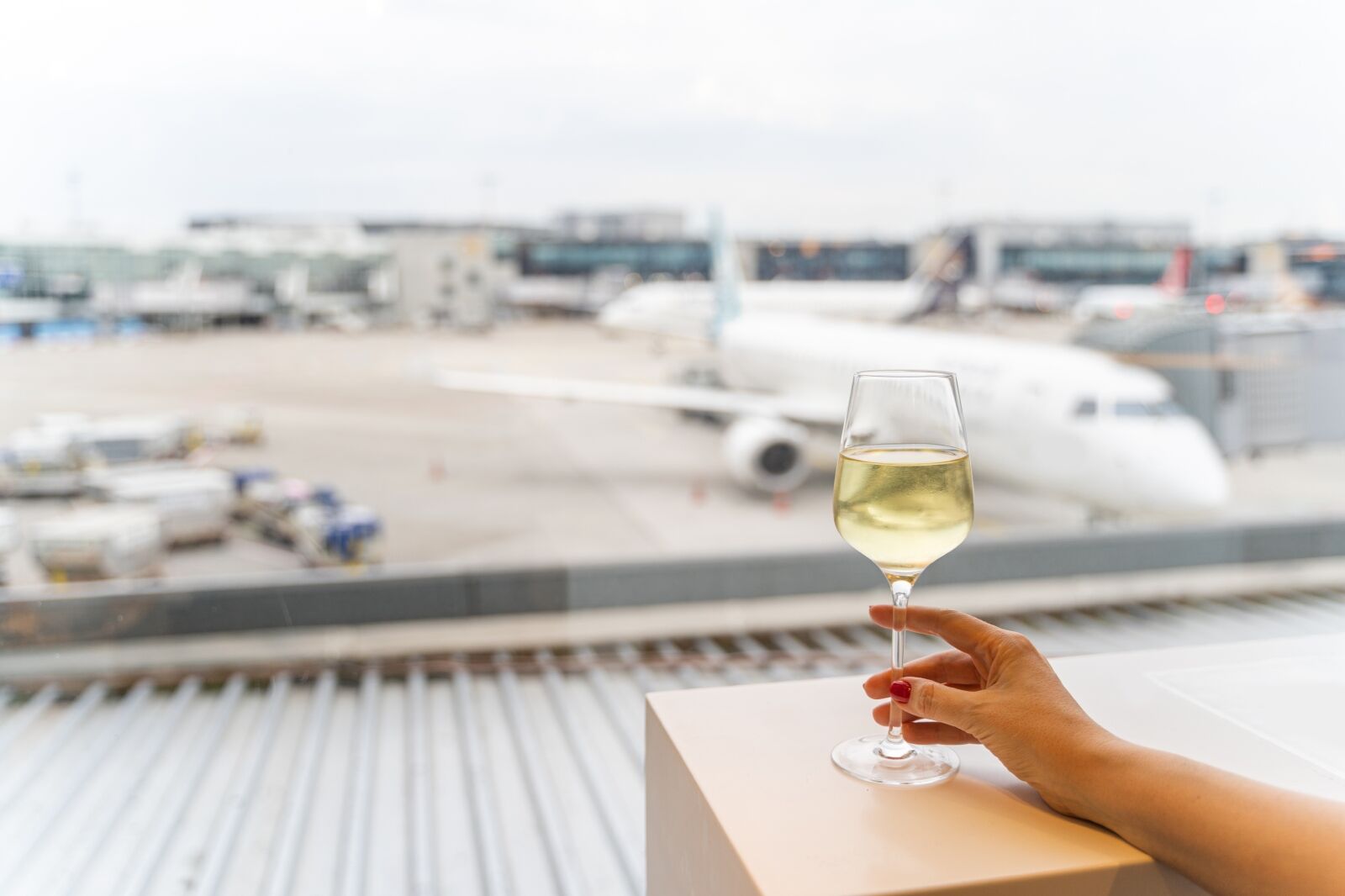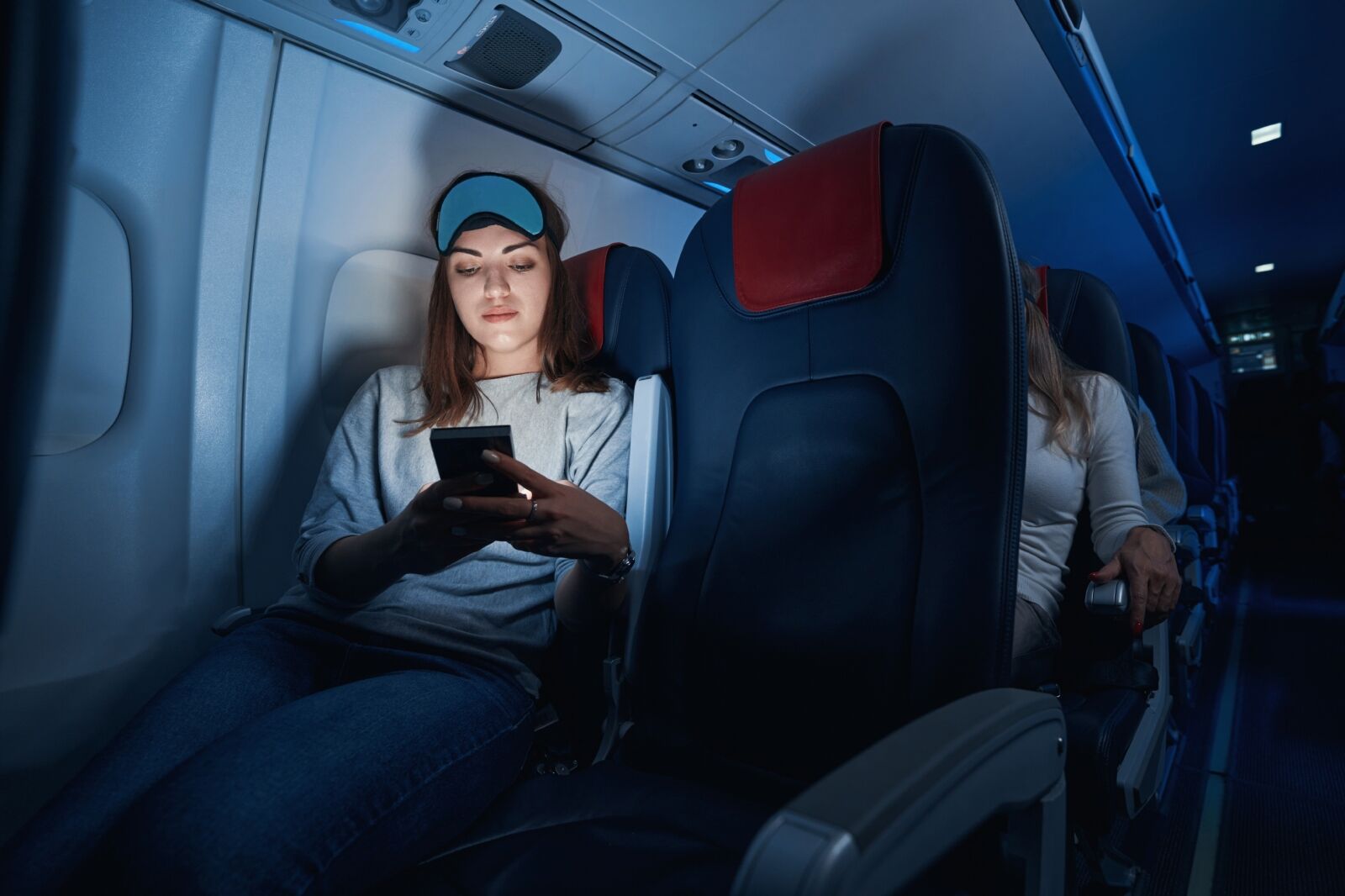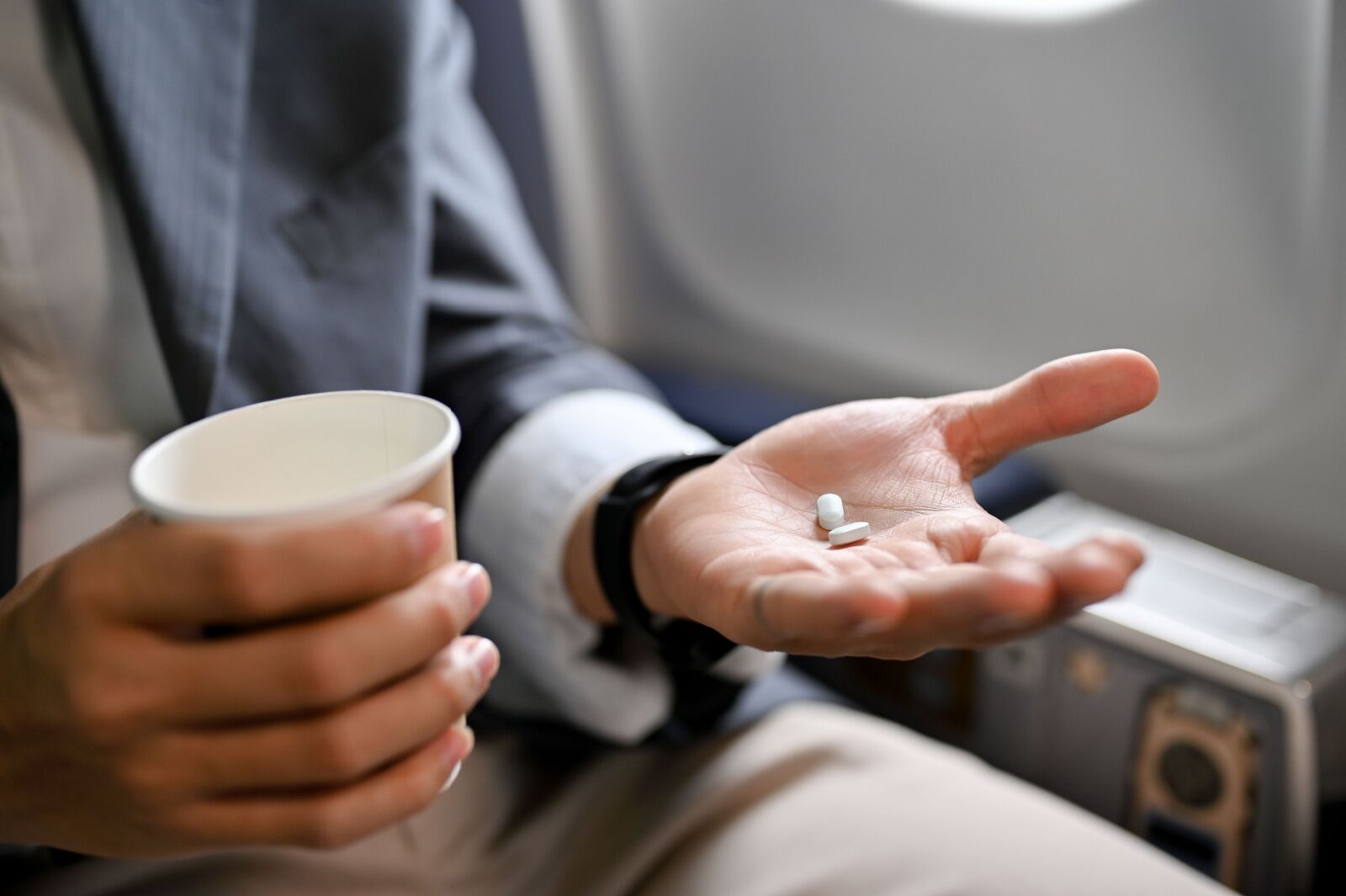Getting quality sleep is one of the most important elements of your overall health, as sleep is the foundation for mental and physical well-being. Sleeping reduces stress, boosts the immune system, enhances cognitive function and learning, and helps regulate emotions. Scientists have done extensive research into the benefits of sleep, and study after study continues to find more and more benefits from getting regular, quality sleep.


That’s one of the major problems with taking an early or redeye flight, taking a trip with multiple legs, and changing time zones. They can throw off your circadian rhythm (the natural cycle of daylight that helps us sleep), which negatively impacts all the cognitive performance tied to sleep. But the timing interruptions to your sleep caused by air travel aren’t the only concern.
Airport and plane environments are not conducive to quality sleep. Mix in nerves, excitement, alcohol, loud noises, in-flight food, and entertainment, and we’ve got a recipe for sleeplessness. Fortunately, if you find it particularly hard to function without a good night’s rest, there are simple things you can do (and not do) to make sure you arrive feeling as fresh as possible at your destination.
Here’s how to sleep on a plane with advice from leading doctors and experts in the field of sleep science.
We hope you love the sleep aids we recommend! Just so you know, Matador may collect a small commission from the links on this page if you decide to book a stay. Listed prices are accurate as of the time of publication.
The top tricks for falling asleep on a plane
Will all of these tricks work? Nope — but ideally, you’ll be able to find one that does. And for some lucky travelers, several of these strategies may work. Goodbye, jet lag (kind of).
Skip alcohol

Save the wine for after you land to maximize your sleep quality. Photo: Pavel Gulea/Shutterstock
For many flyers, having a glass or two of wine before boarding or in the air is a travel tradition, especially if you’re lucky enough to have lounge access with a complimentary bar. And most people know alcohol is a sedative. Because of that, people often mistake it as a sleep aid. But it certainly is not.
Alcohol affects basic brain functions in many ways. Essentially, it sedates your cortex — the section of our brains that controls functions such as consciousness, reasoning, and problem-solving, among other processes — which is why it makes some people feel a bit less stressed and anxious. Unfortunately, for those who enjoy a whiskey nightcap before lift-off, chemical-influenced sedation (and knocking yourself out quicker) is not sleep. Alcohol also leads to poorer quality sleep, which doesn’t help since you’re already going to be contending with changing cabin lights, noise and movement from fellow passengers, and numbness or pain from uncomfortable seats
By having a drink, you’re adding another disruptor to what is already a very poor sleep environment.
Alcohol also blocks your REM (rapid eye movement) sleep. REM sleep is critical for a number of daily functions, including maintaining emotional and mental health and aiding in long-term cognitive abilities, like memory. The study Alcohol and sleep I: effects on normal sleep shows that even moderate amounts of alcohol will diminish your REM sleep percentage. If you’re an anxious flyer, you want all the quality REM sleep you can get, as it will help considerably with keeping your stress down.
The New York Times bestseller Why We Sleep is a great read if you want to learn more about how alcohol disrupts sleep (and how to improve your sleep hygiene),
Control light exposure: eye maks, low light, dim screens

Photo: YAKOBCHUK VIACHESLAV/Shutterstock
Getting as much sunlight as possible in the morning (the start of our awake periods) and little artificial light as possible in the evening (toward the start of sleeping periods) is the best way to improve your circadian rhythm. Most people don’t need to do anything special to follow that recommendation, unless they live in a place with very limited daylight during winter, in which case they may want to invest in a light therapy device.
But in artificial and variable light environments, it’s very difficult for brains to adjust to fluctuating light levels. So your brain can’t figure out what stage it should be in relative to your normal 24-hour, sleep-and-wake cycle.
Dr. Samer Hattar is chief of the Section on Light and Circadian Rhythms at the National Institute of Mental Health, and co-discovered what parts of the eye are responsible for setting circadian rhythms, moods, and appetites. He argues that people can become severely jet-lagged without traveling simply by not getting enough sunlight and spending too much time on devices. Given how many of us are glued to our devices on most days, this writer included, that means most of us will already be in a less-then-ideal state before setting foot in the airport or crossing a date line.
The best things to do are to get 10 to 30 minutes of sunlight first thing in the morning, control exposure to light through the day as needed, and create dim conditions at night, These things are much easier to do at home, but there are a few ways to do these things in airports that may help address how to sleep on a plane.
First, dim your in-flight entertainment system at least an hour before trying to sleep. Also keep your phone turned off. The blue light of electronic devices can suppress melatonin production (the hormone that regulates sleep).
“Decreasing melatonin levels during the day can help you feel more alert and less sleepy,” says Dr. Micahel Breus, the psychologist and clinical sleep specialist behind Sleep Doctor, which provides product recommendations and information about sleep. He’s written extensively on the relationship between light and sleep. “But exposure to blue light in the evening can disrupt healthy sleep-wake cycles by reducing melatonin levels when it is time for sleep.” Breus recommends preparing a sleep kit for flights that includes comfort aids and a blackout eye mask.
Peer-reviewed studies have confirmed that wearing an eye mask can improve sleep quality, provided they are not too tight or too warm. Since we can’t control aircraft temperatures, choose an adjustable eye mask and dress in layers so you don’t overheat.
You might also consider using the app Timeshifter. It “literally takes care of everything,” say Breus, by create a jet lag plan. “I plug in my current time zone, my flight, the time zone of my destination, and my chronotype [natural sleep-wake rhythms], and it gives me a two-day pre-boarding plan, so when I arrive I have zero jet lag,” Breus shared. Timeshifter provides instructions on how to adjust your light exposure, sleep schedule, and caffeine intake to help you adjust to your new time zone more quickly.
Block noise

Photo: Andrey_Popov/Shutterstock
Ear plugs cancel out noise, but depending on the model, they can also help protect the ears from painful air pressure changes. I use Mack’s Flightguard earplugs. The parts that go in your ear are quite soft and comfortable, and an “aero filter” regulates pressure from altitude changes. I’d recommend trying them at home before flying to make sure the fit works for you. Ear plugs are an important part of your tool kit of items to help you sleep on planes, but if you find them uncomfortable, a soft headband, or a thick, noise-cancelling eyemask can help, too. Make sure to pack these items in an easily accessible bag, rather than in your carry-on suitcase that goes in the overhead bin.
Consider sleep supplements

Taking certain vitamins or sleep aids could help for some people. Photo: BongkarnGraphic/Shutterstock
If you’ve got all the above handled, you could look at over-the-country sleep aids, or maybe even sleep medications from a doctor. Popular podcaster and neuroscientist Dr. Andrew Huberman has an interesting episode entitled “Tools for Optimizing Sleep & Sleep-Wake Timing” in which he suggests trying magnesium threonate, apigenin, and theanine to improve sleep quality. You can buy a trio of all three sleep supplements online in travel-friendly capsules. Remember that they can take a few weeks or months to get into your system, so they’re more of a long-term lifestyle choice. If you frequently switch between time zones, looking into supplements could be helpful.
If supplements aren’t doing it for you, you may want to see your doctor about a prescription sleeping aid specifically for travel.
Struggling to sleep on planes? Check out Matador’s rundown of everything that can make it easier for you:
- These Noise-Canceling Headphones Make In-Flight Sleeping a Breeze
- These Affordable Ear Plugs Make Sleeping On a Plane Much Easier
- On Long-Haul Flights, Get Rady To Sleep Like You Do at Home: With Facials and PJs
- My Favorite Under-$20 Hack for Making Every Flight More Comfortable
- This Travel Pillow Prevents Neck and Shoulder Pain For In-Flight Sleep
Tweak your upright position

Sleeping sitting up isn’t good for the body, but there are ways to make it slightly better. Photo: Dmitry Galaganov/Shutterstock
Your sleep position will have the biggest impact on your quality of sleep. Unfortunately, most of us don’t have the luxury of first class space and seat comfort. The average economy seat will push your body into hugely uncomfortable positions, and sitting in one for more than a few hours can be harmful to your body. Unfortunately, this is unlikely to improve, so what can we do to diminish the pressure on joints and muscles to get quality rest?
Ergonomics expert and occupational therapist Carla Jaspers from Work Up Ergonomics says travelers need to plan ahead. Sleeping in a seated posture is awkward, and will compress vertebrae and force painful weight baring on the lower extremities, hips, pelvis, and spine. Even if you can’t sleep lying down, there are a couple of things you can do to get quality sleep, rather than a quick nap.
The first is to recline the seat, even a few degrees. This will put your spine in better alignment. You should also put a cushion or a rolled-up soft item of clothing at the bottom of your spine for lumbar reinforcement.
Matador Network spoke to Logan Foley, a certified sleep science coach at the Sleep Foundation, about the best neck pillows on the market. “When looking at and evaluating travel pillows, the most important thing for me is support, meaning how well it holds the head up when sleeping upright,” shares Logan. The more you can stop your head from tipping forward or to either side, will also help you achieve a better quality of sleep. One of the best options is a wrap-around neck pillow that helps with forward and lateral flexion and doesn’t move around like the standard U-shaped designs.
The good news is your seat preference doesn’t really matter. Other than avoiding the middle seat so you get jostled less, choosing the window or aisle seat won’t really matter in terms of improving your chances of sleep.
Try to practice the “3-2-1 sleep rule”
What is the 3-2-1 sleep rule, you say? The “three-two-one” rule is pretty much all of the above, plus avoiding caffeine 10 hours before sleep and never hitting snooze on your alarm. Three refers to no heavy meals or alcohol three hours before bed, which may mean skipping the in-flight dining and eating prior to boarding. The next suggestion is to stop work or stressful activities two hours before sleeping. Winding down is crucial for preparing your mind and body for sleep. And avoid screens for at least one hour prior.
Breathing techniques that can help you sleep on planes
There are breathing techniques to help you fall asleep on planes, or at least lower your stress and anxiety levels to make you calmer and hopefully, fall asleep faster). Breathwork is the practice of purposefully breathing in a specific way. Well-known techniques for trying to sleep on planes include “4-7-8” breathing, and the military method.
The goal is to use breathing to rapidly reduce stress levels in real-time from the “comfort” of your airplane seat.
What is the 4-7-8 breathing method?
The 4-7-8 technique was popularized by Dr. Andrew Weil, an integrative medicine physician and author of best-selling titles such as Mind Over Meds, Fast Food, True Food, and Spontaneous Happiness. Weil learned the concept from a yogi guru in India and adapted it for Western audiences. Dr. Weil describes it as a “natural tranquilizer for the nervous system” and promotes its use for managing stress, anxiety, and insomnia.
On a popular podcast, he told listeners the basics of how to do it. Take a slow, gentle breath through the nose while counting to four, hold it for a count of seven, then blow it out through the mouth for eight seconds. Repeat it four times when you’re just getting started. He advises that it works best when you practice it daily, even eventually, you can increase to eight breath cycles. He’s gone on the record many times as saying it’s the best measure he’s ever tried for reducing anxiety, which can help you fall asleep faster.
Though you may initially feel a tad self-conscious doing active breathwork in-flight, you shouldn’t. The benefits of purposeful breathing are so well researched and documented that if anything, you may inspire fellow passengers to utilize the technique.
The military sleep method
Service members are trained to sleep in some of the harshest environments on earth. Service men and women train to sleep in small windows of two to five hours, which can help them while deployed in places where sleep is hard to come by. That’s why many use the military sleep method in order to fall asleep quickly in loud and uncomfortable environments. It was introduced in the book Relax and Win: Championship Performance, written by one of the world’s best track and sprint coaches, Bud Winter. Here’s a run down of how it works:
- First, practice progressive muscle relaxation: Start by tensing and relaxing different muscle groups, starting with your face and working your way down to your toes. Focus on feeling the tension release with each exhale.
- Then start deep breathing: Breathe deeply and slowly, focusing on expanding your diaphragm rather than your chest. Inhale for a count of four, hold for seven and exhale for eight.
- Next, focus on mental imagery: Choose a calming image, like a dark room or a body of water. Focus on all the sensory details of your chosen image. Try not to let tour mind wander, but if it does, it’s okay. Just bring your focus back to your breath or image. Repeat “don’t think” for 10 seconds if needed.
- Finally, embrace the stillness: As you relax, allow your body to remain still and avoid fidgeting.
There’s a lot to try here, from having the right travel products to breathwork to small hacks like putting a little extra padding below your spine. But with a little practice, most people can probably make the process of figuring out how to sleep on a plane at least a little easier. And since many or these techniques are scientifically proven to relax the body and mind, there’s very little to lose and lots to gain. So why not give one a try?